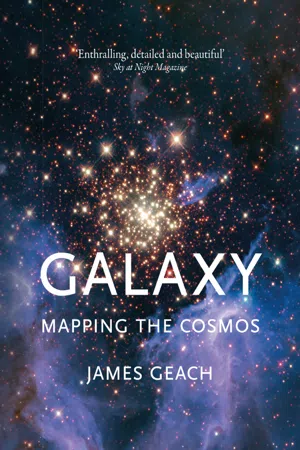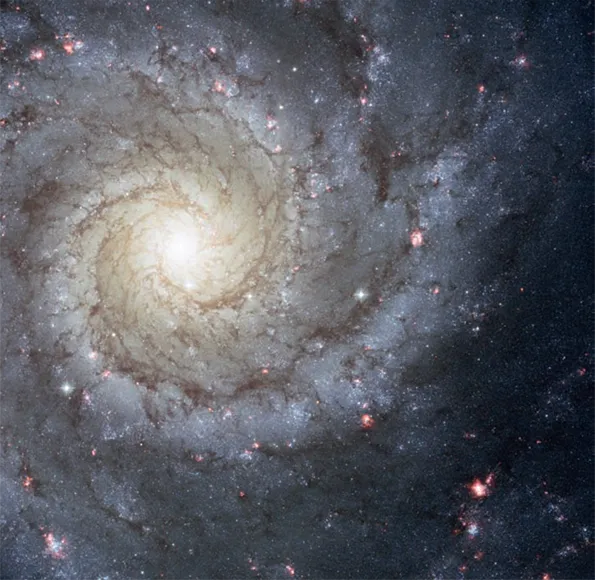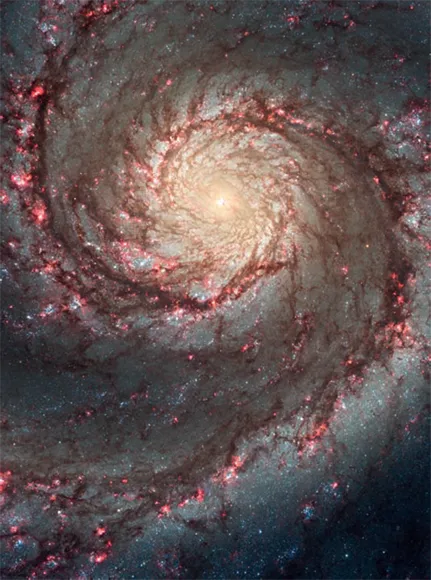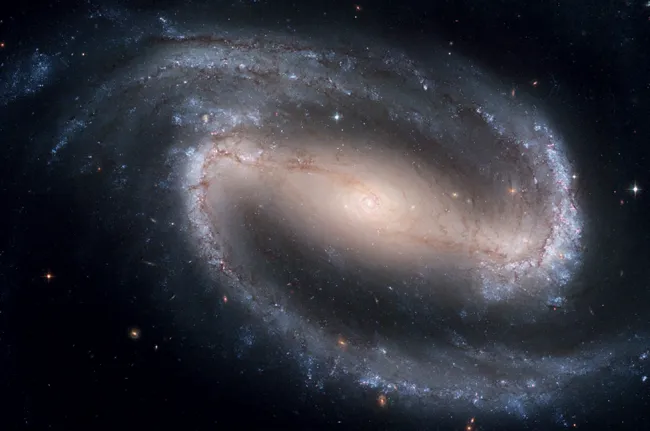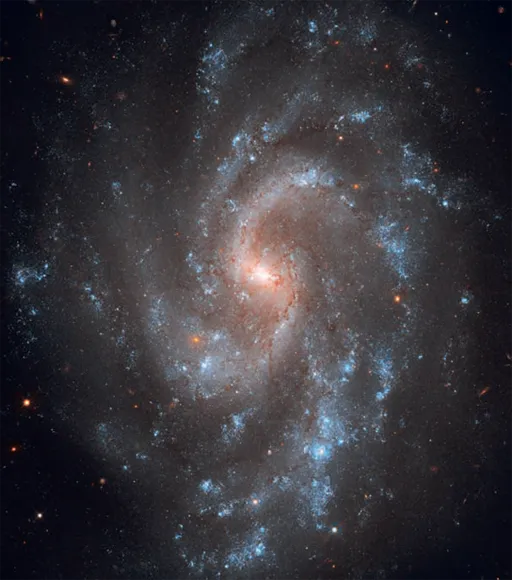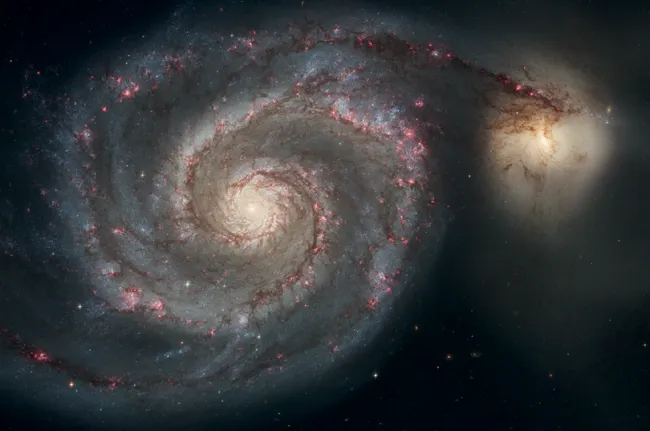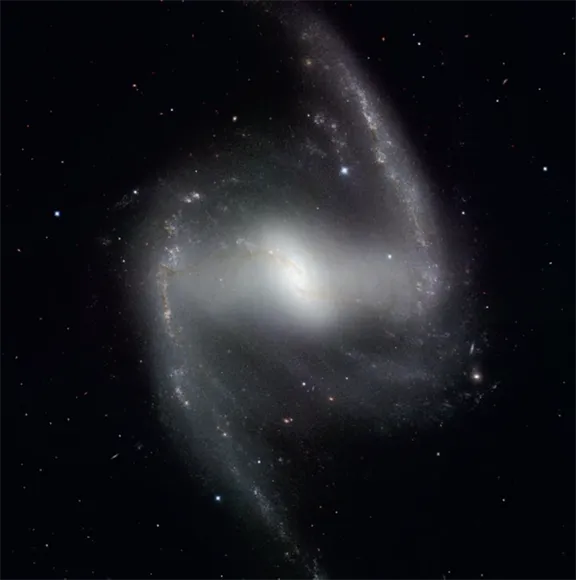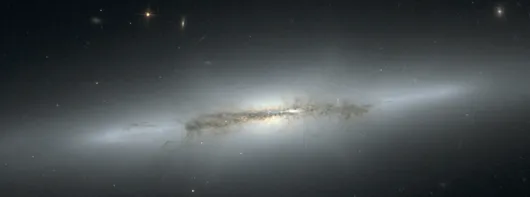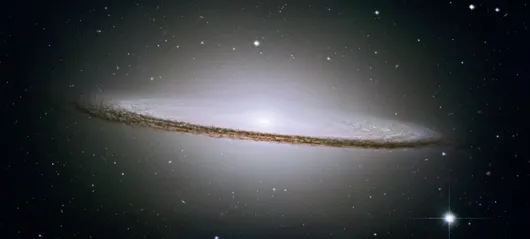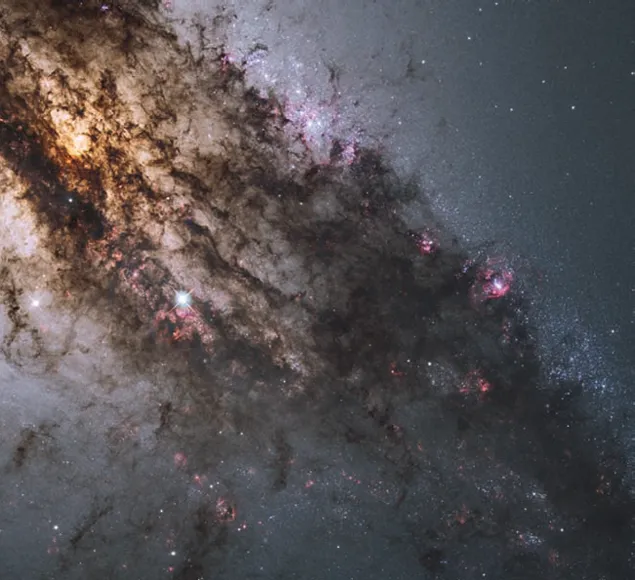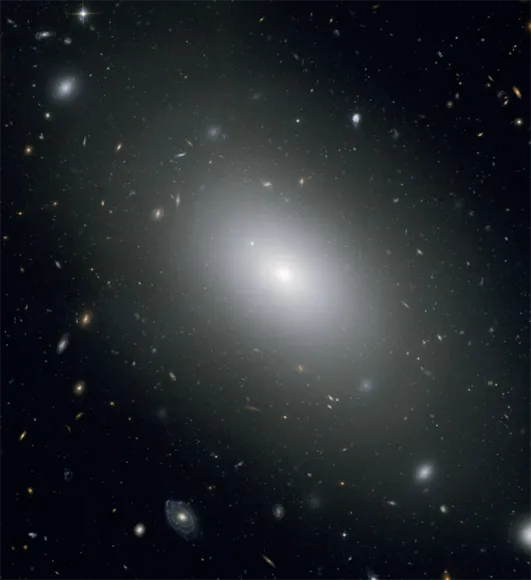![]()
TWO
Stepping into the Extragalactic Universe
Our galaxy is one of billions. Rather than all looking roughly the same, there is a rich variety in the types of galaxy that are out there. There are indeed many galaxies like our own spiral Milky Way, so called ‘grand design’ spirals (which is simply a shorthand way of describing the complexity of these objects) with different levels of spiral structure (some are wound tighter than others, for example). There are spiral galaxies with a linear ‘bar’ going through the hub; small, irregular and amorphous galaxies; merging and interacting galaxies with contorted shapes; and finally the massive galaxies with no discernable disc, but just a huge spherical or elliptical congregation of stars. These galaxies have different chemical compositions, contain different types of star and are forming new stars at a variety of rates. The Milky Way forms the equivalent mass of a few Suns in new stars every year; the most active galaxies can form new stars at rates hundreds of times faster than this, and some galaxies don’t form any new stars at all. The galaxies are also not randomly distributed in space: they cluster together in a pattern determined by the underlying, omnipresent gravity. Different types of galaxy tend to be distributed in different ways. The goal of my research is to contribute to our understanding of why galaxies are the way they are and how they came to be. Why are there as many galaxies as there are? What processes have shaped them, and how has this changed over the history of the universe? Everything we know about galaxies today has come from patient decades of passive observations of the sky, as we have gradually collected the data from which we can glean important clues to answer these questions.
It should be becoming clear that there is something that the different components of galaxies have in common: they all emit light of some form or another, or, in some cases, block out light. If we can detect those different forms of light, or detect the ‘absence’ of light, then we can map out our galaxy and others and break them down into their constituent parts. That’s how we learn about the universe: we cannot observe or measure the material in a tactile way; we are totally reliant on detecting – or not detecting – photons that are emitted, absorbed or reflected.
Face-on ‘grand design’ galaxy Messier 74, providing a spectacular view of the different components of a spiral galaxy, orientated face-on to our vantage point. The bright white-yellow-orange core glows with the light of billions of stars that are on average older than the blue (younger) stars seen throughout the disc. Patches of red are the brushfire-like HII regions where hydrogen has been ionized by new stars in giant clouds of molecular gas, the same as we see in our own galaxy. Laced through the disc and tracing the spiral arms is the dark signature of interstellar dust, the ashes of ancient stars.
The heart of the Whirlpool galaxy, another beautiful spiral galaxy orientated face-on to us, revealing the intricate structure of these ‘island universes’. The two spiral arms emanating from the core are particularly bright with HII regions and thick lanes of dust. Note how the location of the dark dust and sites of active star formation are correlated.
A spectacular view of the spiral galaxy NGC 4921 in the Coma cluster of galaxies. The arms in this galaxy are not as pronounced as in other spirals (such as the Whirlpool), probably because of the fact that NGC 4921 is not forming stars as rapidly in its disc. This may well be related to the dense cluster environment: some of the gas required for star formation might have been removed from the disc during the galaxy’s passage through the hot, dense intracluster medium. The background reveals myriad distant galaxies of many different types; they appear much smaller and fainter than NGC 4921.
The Black Eye galaxy, M64, an example of a spiral galaxy that is particularly awash with a thick lane of dust at its centre, obscuring much of the starlight.
NGC 1300, a barred spiral galaxy. The prominent spiral arms emanating from the ends of the linear bar structure are lit by young, hot, blue stars and star-forming regions, whereas the central regions are noticeably redder, indicating that the stellar population is, on average, more mature. ust visible in the very central region of the galaxy is another spiral structure representing a nuclear disc of gas and stars where star formation is also occurring. The bar structure is in part responsible for transporting gas and stars from the disc to the centre of the galaxy, as it redistributes angular momentum. Bars are important in shaping the formation of the bulges of some galaxies.
Galaxy NGC 5584, a ‘flocculant’ spiral galaxy ablaze with new, young, blue stars forming in patches throughout the disc. Flocculant spirals have a less well-defined spiral structure than so-called ‘grand design’ spirals: as in this case, they can be characterized by a clumpy, almost diffuse, structure, although the semblance of the spiral morphology can still be seen.
The central region of the spiral galaxy NGC 2841, beautifully contrasting the bright, smooth yellow-orange core – the hub of the disc – with winding spiral arms tattooed with dust, and punctuated here and there by blue clusters of new stars. As observers, we are embedded within the disc of a galaxy similar to this, looking out through the stars, gas and dust to the extragalactic universe beyond.
A wider view of the Whirlpool galaxy, M51. The large spiral is interacting with a smaller, more irregular galaxy appearing at the tip of one of the spiral arms. The gravitational interaction of the passage of this companion (which may well have passed through the disc of M51) is likely to have had an influence on the spiral arms, which are extremely well defined in this example, bright with new stars and HII regions.
A near-infrared view of the barred spiral galaxy NGC 1365. The formation of bars – structures joining the spiral arms to the central hub – is due to gravitational perturbations in the overall rotation of the spiral disc, causing some stars’ orbits to become very elongated, forming the bar. Up to two-thirds of spiral galaxies today contain bar structures, including our own galaxy.
If you think about it, the same is true in everyday experience: unless you go and actually put your hand on something, you either have to see it or hear it to know that it’s there. In the case of eyesight, you’re seeing photons that are either being emitted from an object directly (say, from a light bulb) or reflected from some object back into your eyes, like the scattering by dust motes of a shaft of sunlight, or your reflection in a mirror. Or, in the case of hearing, an object is somehow vibrating the air; perhaps the wings of a buzzing insect, making pressure waves that travel to your ear, vibrate your eardrum and are converted to sound in your brain. In both cases, you’re not actually in physical contact with the object, but can learn something about its properties from the transmitted radiation. I can tell that grass is green, and therefore learn something about the biology of grass, without touching it, for example.
We started out just using our eyes, which were eventually aided by telescopes. Our eyes are sensitive to radiation with a fairly narrow range of energies, or frequencies, which we perceive as colour. The range of these frequencies roughly corresponds to the peak range of electromagnetic radiation that is emitted by the Sun and reaches the surface of the Earth. This is no biological coincidence; our eyes evolved so that we could ‘see’ this radiation, which is clearly a powerful evolutionary advantage. But the visible light is just a fragment of a continuous electromagnetic spectrum of radiation, emitted by different processes all over the universe. We have already learned how light with slightly longer wavelengths than the light we can actually see with our eyes can be used to penetrate the interstellar dust, for example. Today we have developed instruments we can attach to telescopes that can detect radiation right across the spectrum, ranging from gamma and x-rays (very high frequency, high energy) to radio waves (low frequency, low energy). Galaxies emit photons of every sort and, as we’ll see, only by measuring them all can we be sure we have conducted a full ‘census’ of the astrophysics that governs the nature of galaxies.
Astronomy as an empirical science is unusual because we cannot conduct controlled experiments in the same way that ‘laboratory’ scientists do. Instead, from our limited vantage point – this one coordinate in the universe that we call Earth – we simply have to gaze out and soak up as much light as possible. Encoded within that light is the history of the universe. Astronomy is a bit like archaeology. Archaeologists can’t just go and ask Julius Caesar what he had for breakfast; that has to be determined from other evidence. In fact, the parallels are a little deeper than that. Just as archaeologists look back into the past, so do astronomers when they look into deep space. The reason is that the distances between other galaxies and us are so huge that light from them takes an appreciable amount of time to get here. Hence the origin of the unit ‘light year’: the distance light travels in one year. So, just as when you hear a thunderclap you are hearing the boom emitted at the time you saw the lightning, which could be some seconds ago, when we look at galaxies we’re seeing them as they were when they emitted their light. This can be billions of years ago, because the distances are so immense. The same effect is true of the light from our Sun. It’s far enough away that it takes light eight minutes to traverse the inner solar system to Earth. So when you look up at the Sun (shielding your eyes, of course), you see it as it was nearly ten minutes ago. When you look at the Moon, you are looking back about one second into the past. Of course, light takes a finite time to traverse any distance, and so this time delay even applies to everyday life; it’s just that the speed of light is so large in comparison to the human distance scale that we don’t notice it.
NGC 4710 in the Virgo cluster of galaxies is an example of an edge-on view of a spiral galaxy, so we can see the typical thickness of the disc and the round central bulge. Like most spirals, NGC 4710 has a clear dust lane concentrated in the mid-plane, obscuring and ‘reddening’ the central regions of the galaxy, just as in the Milky Way. Still, the prominent yellowish bulge of stars at the hub of the disc is clearly visible, as is the stellar ‘envelope’ of stars, which forms a diffuse white glow around the bulge and disc.
Messier 104, or the Sombrero galaxy, is one of the most famous galaxies in the sky because of its distinctive morphology: a nearly elliptical, smooth bulge of stars combined with a very clearly defined dusty disc. We see the Sombrero nearly edge-on, but the disc is very slightly inclined to our view.
The lenticular type Spindle galaxy, seen edge-on in this Hubble Space Telescope view. The extended white glow is the combined light of billions of stars, a large fraction of which are in the central bulge that dominates this galaxy. The prominent dust lane traces out the mid-plane of the disc, almost completely obscuring the light behind. Although lenticular galaxies are generally ‘passive’ – no longer forming stars – the dust was produced earlier in the galaxy’s life when it was more active, and so hints at the past evolution of the Spindle. The formation of lenticular galaxies is not completely understood, but one possibility is that they have evolved from certain massive spiral galaxies.
Another famous galaxy, the massive elliptical galaxy Centaurus A, imaged in optical light. Cen A is characterized by the warped dust lane snaking across its face.
A close-up view of the centre of Centaurus A, thick with interstellar dust, but fringed by new blue stars and the glow of HII regions. Centaurus A is an active galaxy that is undergoing a starburst and central black hole growth.
Elliptical galaxy NGC 1132, a beautiful illustration of the smooth, unblemished, spheroidal morphology of these massive, ancient galaxies. Ellipticals are generally ‘passive’ – no longer forming new stars. They underwent most of their stellar mass assembly earlier in the history of the universe, when the overall rate of galaxy formation was much higher than it is today. Ellipticals tend to be found in the densest environments – groups and clusters of galaxies – and are likely to have undergone significant merger activity in the past. Dotted around NGC 1132 can be seen thousands of globular clusters, appearing here as small pinpricks of light around the stellar envelope. As always, the background is filled with other, more distant galaxies: the cities beyond.
This time delay provides astronomers with a handy tool: we can actually see what is (or rather, was) happening in the early universe simply by looking at distant galaxies. It is literally like having a window on the past. The purpose of extragalactic astronomy is not only to audit the contents of the universe, but to see how these have changed over time, and construct a physical model to understand it all. But how is astronomy actually done?
Observational astronomers throughout history, almost without exception, have been interested in one thing: collecting photons. We are light hunters. Those photons are the only direct connection we have to the distant universe, they having travelled for perhaps billions of years from a distant star or gas cloud to Earth, mostly unimpeded, but occasionally being absorbed and re-emitted or otherwise transformed or deflected along the way. Encoded within this steady rain of light is all the information we have to go on in order to understand the history of the cosmos. Unfortunately, given the tremendous distances involved, the amount of energy arriving at the Earth from any one galaxy is almost unimaginably – one might even say vanishingly – small. The problem is compounded as we try to look further: galaxies appear smaller and fainter, and are hard to detect. To make matters worse, the tiny signal – the small portion of light hitting our detectors that is an iota of the whole – is drowned among a blazing sea of electromagnetic contamination, both natural and artificial: sunlight, street lights, radio transmissions and the infrared glow of water in the atmosphere. To this end, astronomers have had to become ever more wily in their strategies for capturing this precious commodity, and the techniques they use to distil it into something meaningful.
It all boils down to two essential pieces of equipment: a telescope that can capture and focus light, and a detector to record it. The cutting edge of our science has always been honed through the development of the biggest telescopes and the most sensitive cameras and detectors. Unfortunately, astronomical instrumentation is both complex and expensive, and inevitably becomes more so over time. Most professional astronomers like me don’t perform our research with the telescopes connected to o...
